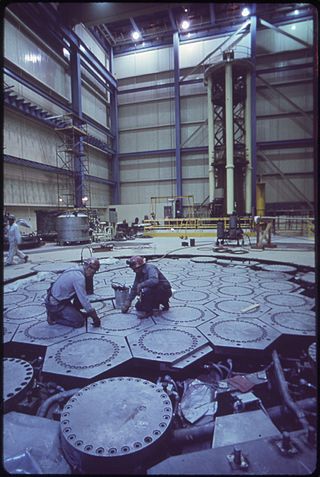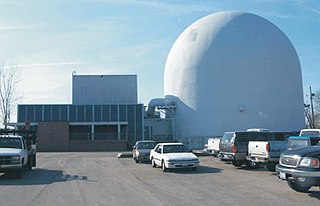Related Research Articles

A nuclear reactor is a device used to initiate and control a fission nuclear chain reaction or nuclear fusion reactions. Nuclear reactors are used at nuclear power plants for electricity generation and in nuclear marine propulsion. Heat from nuclear fission is passed to a working fluid, which in turn runs through steam turbines. These either drive a ship's propellers or turn electrical generators' shafts. Nuclear generated steam in principle can be used for industrial process heat or for district heating. Some reactors are used to produce isotopes for medical and industrial use, or for production of weapons-grade plutonium. As of 2022, the International Atomic Energy Agency reports there are 422 nuclear power reactors and 223 nuclear research reactors in operation around the world.

A pressurized water reactor (PWR) is a type of light-water nuclear reactor. PWRs constitute the large majority of the world's nuclear power plants. In a PWR, the primary coolant (water) is pumped under high pressure to the reactor core where it is heated by the energy released by the fission of atoms. The heated, high pressure water then flows to a steam generator, where it transfers its thermal energy to lower pressure water of a secondary system where steam is generated. The steam then drives turbines, which spin an electric generator. In contrast to a boiling water reactor (BWR), pressure in the primary coolant loop prevents the water from boiling within the reactor. All light-water reactors use ordinary water as both coolant and neutron moderator. Most use anywhere from two to four vertically mounted steam generators; VVER reactors use horizontal steam generators.

The Advanced Gas-cooled Reactor (AGR) is a type of nuclear reactor designed and operated in the United Kingdom. These are the second generation of British gas-cooled reactors, using graphite as the neutron moderator and carbon dioxide as coolant. They have been the backbone of the UK's nuclear power generation fleet since the 1980s.

The RBMK is a class of graphite-moderated nuclear power reactor designed and built by the Soviet Union. The name refers to its design where, instead of a large steel pressure vessel surrounding the entire core, the core is surrounded by a cylindrical annular steel tank inside a concrete vault and each fuel assembly is enclosed in an individual 8 cm (inner) diameter pipe. The channels also contain the coolant, and are surrounded by graphite.

A fast-neutron reactor (FNR) or fast-spectrum reactor or simply a fast reactor is a category of nuclear reactor in which the fission chain reaction is sustained by fast neutrons, as opposed to slow thermal neutrons used in thermal-neutron reactors. Such a fast reactor needs no neutron moderator, but requires fuel that is relatively rich in fissile material when compared to that required for a thermal-neutron reactor. Around 20 land based fast reactors have been built, accumulating over 400 reactor years of operation globally. The largest of this was the Superphénix Sodium cooled fast reactor in France that was designed to deliver 1,242 MWe. Fast reactors have been intensely studied since the 1950s, as they provide certain advantages over the existing fleet of water cooled and water moderated reactors. These are:

A molten salt reactor (MSR) is a class of nuclear fission reactor in which the primary nuclear reactor coolant and/or the fuel is a mixture of molten salt with a fissionable material.

The supercritical water reactor (SCWR) is a concept Generation IV reactor, designed as a light water reactor (LWR) that operates at supercritical pressure. The term critical in this context refers to the critical point of water, and should not be confused with the concept of criticality of the nuclear reactor.
Generation IVreactors are nuclear reactor design technologies that are envisioned as successors of generation III reactors. The Generation IV International Forum (GIF) – an international organization that coordinates the development of generation IV reactors – specifically selected six reactor technologies as candidates for generation IV reactors. The designs target improved safety, sustainability, efficiency, and cost. The World Nuclear Association in 2015 suggested that some might enter commercial operation before 2030.

A high-temperature gas-cooled reactor (HTGR) is a type of gas-cooled nuclear reactor which use uranium fuel and graphite moderation to produce very high reactor core output temperatures. All existing HTGR reactors use helium coolant. The reactor core can be either a "prismatic block" or a "pebble-bed" core. China Huaneng Group currently operates HTR-PM, a 250 MW HTGR power plant in Shandong province, China.

The lead-cooled fast reactor is a nuclear reactor design that features a fast neutron spectrum and molten lead or lead-bismuth eutectic coolant. Molten lead or lead-bismuth eutectic can be used as the primary coolant because especially lead, and to a lesser degree bismuth have low neutron absorption and relatively low melting points. Neutrons are slowed less by interaction with these heavy nuclei and therefore, help make this type of reactor a fast-neutron reactor. In simple terms, if a neutron hits a particle with a similar mass, it tends to lose kinetic energy. In contrast, if it hits a much heavier atom such as lead, the neutron will "bounce off" without losing this energy. The coolant does, however, serve as a neutron reflector, returning some escaping neutrons to the core. Fuel designs being explored for this reactor scheme include fertile uranium as a metal, metal oxide or metal nitride. Smaller capacity lead-cooled fast reactors can be cooled by natural convection, while larger designs use forced circulation in normal power operation, but will employ natural circulation emergency cooling. No operator interference is required, nor pumping of any kind to cool the residual heat of the reactor after shutdown. The reactor outlet coolant temperature is typically in the range of 500 to 600 °C, possibly ranging over 800 °C with advanced materials for later designs. Temperatures higher than 800 °C are theoretically high enough to support thermochemical production of hydrogen through the sulfur-iodine cycle, although this has not been demonstrated.

The water-water energetic reactor (WWER), or VVER is a series of pressurized water reactor designs originally developed in the Soviet Union, and now Russia, by OKB Gidropress. The idea of such a reactor was proposed at the Kurchatov Institute by Savely Moiseevich Feinberg. VVER were originally developed before the 1970s, and have been continually updated. As a result, the name VVER is associated with a wide variety of reactor designs spanning from generation I reactors to modern generation III+ reactor designs. Power output ranges from 70 to 1300 MWe, with designs of up to 1700 MWe in development. The first prototype VVER-210 was built at the Novovoronezh Nuclear Power Plant.

The BN-600 reactor is a sodium-cooled fast breeder reactor, built at the Beloyarsk Nuclear Power Station, in Zarechny, Sverdlovsk Oblast, Russia. It has a 600 MWe gross capacity and a 560 MWe net capacity, dispatched o the Middle Urals power grid. It has been in operation since 1980 and represents an evolution on the preceding BN-350 reactor. In 2014, its larger sister reactor, the BN-800 reactor began operation.
International Reactor Innovative and Secure (IRIS) is a Generation IV reactor design made by an international team of companies, laboratories, and universities and coordinated by Westinghouse. IRIS is hoped to open up new markets for nuclear power and make a bridge from Generation III reactor to Generation IV reactor technology. The design is not yet specific to reactor power output. Notably, a 335 MW output has been proposed, but it could be tweaked to be as low as a 100 MW unit.

Gen4 Energy, Inc was a privately held corporation formed to construct and sell several designs of relatively small nuclear reactors, which they claimed would be modular, inexpensive, inherently safe, and proliferation-resistant. According to news coverage, these reactors could be used for heat generation, production of electricity, and other purposes, including desalination.
A nuclear reactor coolant is a coolant in a nuclear reactor used to remove heat from the nuclear reactor core and transfer it to electrical generators and the environment. Frequently, a chain of two coolant loops are used because the primary coolant loop takes on short-term radioactivity from the reactor.
The BN-800 reactor is a sodium-cooled fast breeder reactor, built at the Beloyarsk Nuclear Power Station, in Zarechny, Sverdlovsk Oblast, Russia. The reactor is designed to generate 880 MW of electrical power. The plant was considered part of the weapons-grade Plutonium Management and Disposition Agreement signed between the United States and Russia. The reactor is part of the final step for a plutonium-burner core The plant reached its full power production in August 2016. According to Russian business journal Kommersant, the BN-800 project cost 140.6 billion rubles.

The BN-1200 reactor is a sodium-cooled fast breeder reactor project, under development by OKBM Afrikantov in Zarechny, Russia. The BN-1200 is based on the earlier BN-600 and especially BN-800, with which it shares a number of features. The reactor's name comes from its electrical output, nominally 1220 MWe.
The HTR-PM is a Chinese small modular nuclear reactor. It is a high-temperature gas-cooled (HTGR) pebble-bed generation IV reactor based on the German AVR design. The technology is intended to replace coal-fired power plants in China's interior, in line with the country's plan to reach carbon neutrality by 2060.
The BREST reactor is a Russian conceptual design for a lead-cooled fast reactor based on a generation IV reactor. Two designs are planned, the BREST-300 and the BREST-1200. The main characteristics of the BREST reactor are passive safety and a closed fuel cycle.

An organic nuclear reactor, or organic cooled reactor (OCR), is a type of nuclear reactor that uses some form of organic fluid, typically a hydrocarbon substance like polychlorinated biphenyl (PCB), for cooling and sometimes as a neutron moderator as well.
References
- ↑ "Generation IV & SMR". www.ansaldoenergia.com.
- ↑ "Nuclearelectrica to cooperate in development of ALFRED : New Nuclear - World Nuclear News". world-nuclear-news.org.
- ↑ "Contract for Romanian lead-cooled reactor research facility : New Nuclear - World Nuclear News". world-nuclear-news.org.